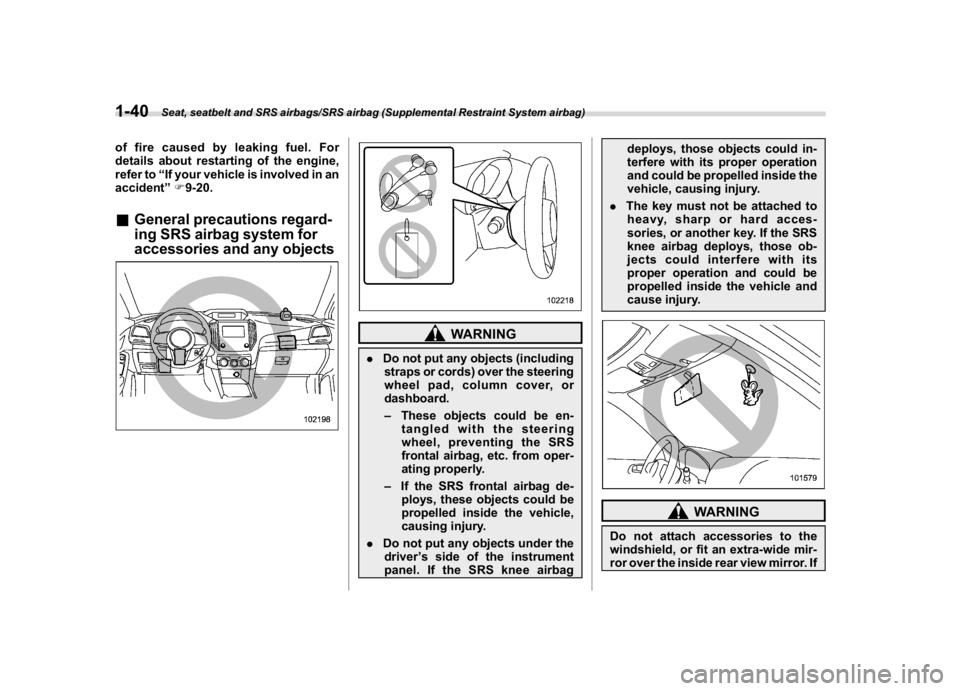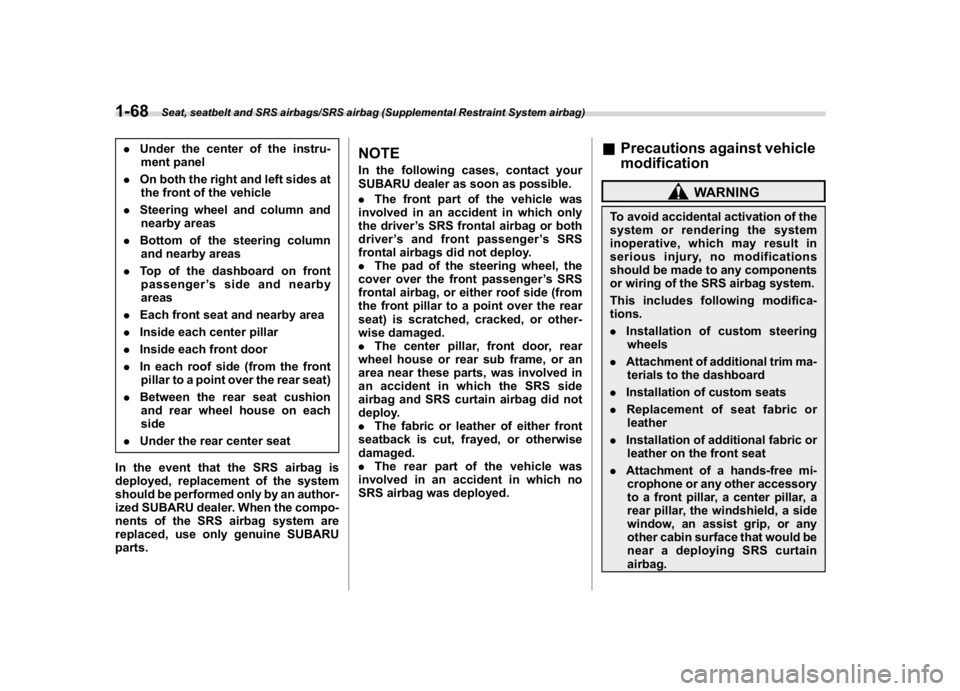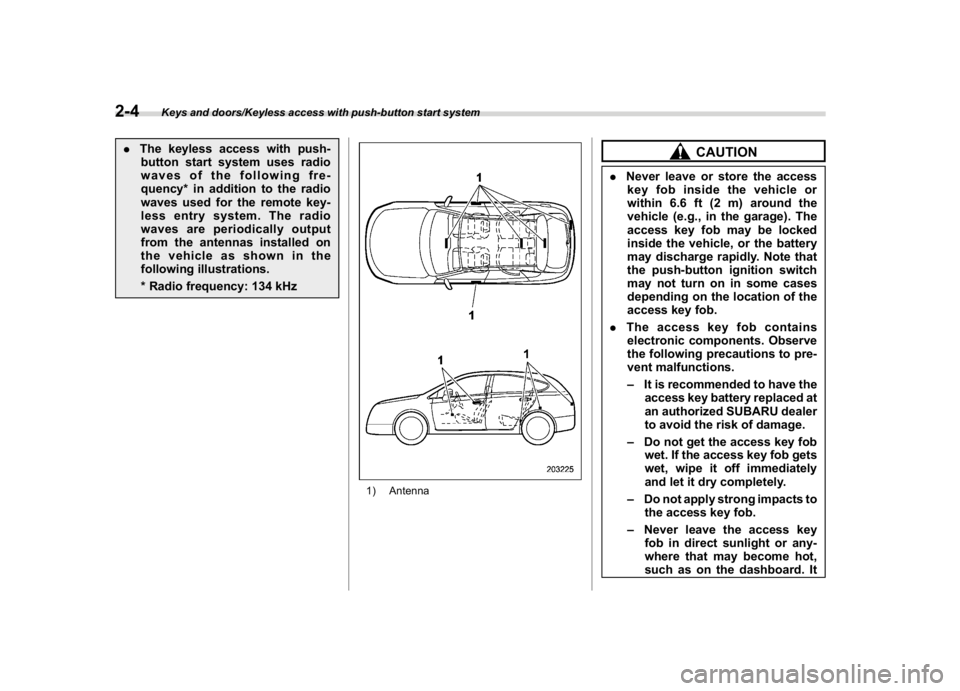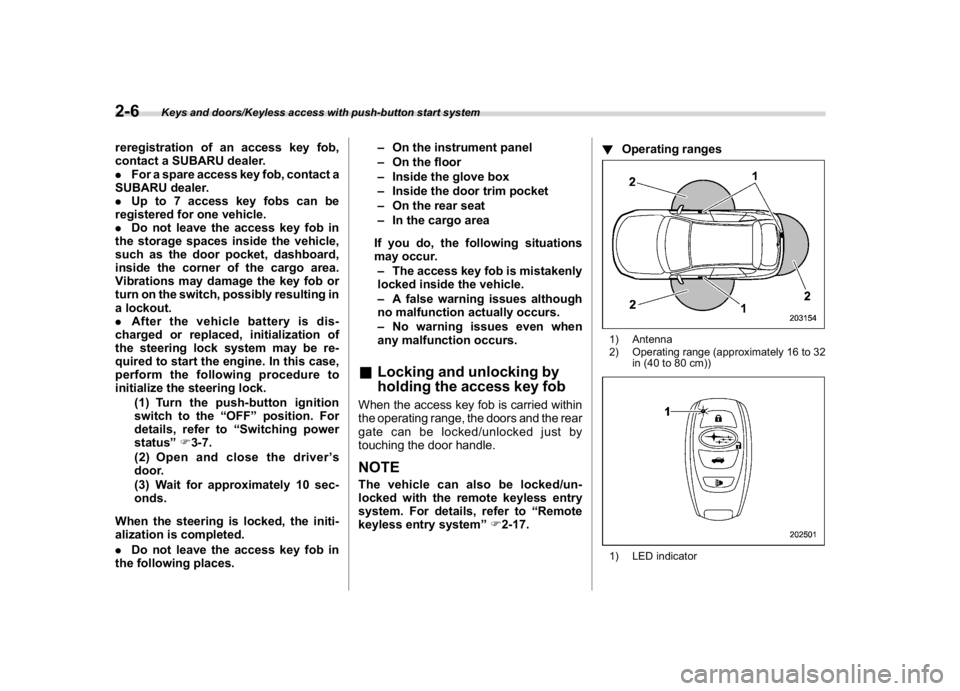2018 SUBARU CROSSTREK dashboard
[x] Cancel search: dashboardPage 69 of 474

(70,1)
北米Model "A1320BE-C" EDITED: 2017/ 10/ 10
of fire caused by leaking fuel. For
details about restarting of the engine,
refer to“If your vehicle is involved in an
accident”F9-20.&General precautions regard-
ing SRS airbag system for
accessories and any objects
WARNING
.Do not put any objects (including
straps or cords) over the steering
wheel pad, column cover, or
dashboard.
–These objects could be en-
tangled with the steering
wheel, preventing the SRS
frontal airbag, etc. from oper-
ating properly.
–If the SRS frontal airbag de-
ploys, these objects could be
propelled inside the vehicle,
causing injury.
.Do not put any objects under the
driver’s side of the instrument
panel. If the SRS knee airbagdeploys, those objects could in-
terfere with its proper operation
and could be propelled inside the
vehicle, causing injury.
.The key must not be attached to
heavy, sharp or hard acces-
sories, or another key. If the SRS
knee airbag deploys, those ob-
jects could interfere with its
proper operation and could be
propelled inside the vehicle and
cause injury.
WARNING
Do not attach accessories to the
windshield, or fit an extra-wide mir-
ror over the inside rear view mirror. If
Seat, seatbelt and SRS airbags/SRS airbag (Supplemental Restraint System airbag)
1-40
Page 74 of 474

(75,1)
北米Model "A1320BE-C" EDITED: 2017/ 10/ 10
&Components1) Driver’s SRS frontal airbag
2) Front passenger’s SRS frontal airbag
3) SRS side airbag
4) SRS curtain airbag
5) SRS knee airbag
The SRS airbags are stowed in the
following locations.
Driver’s SRS frontal airbag: in the center
portion of the steering wheel
A“SRS AIRBAG”mark is located at the
pad of the airbag.
Front passenger’s SRS frontal airbag:
near the top of the dashboard under the
“SRS AIRBAG”mark
SRS side airbag: in the door side of each
front seat seatback which bears an“SRS
AIRBAG”label
SRS curtain airbag: in the roof side
(between the front pillar and a point behind
the rear quarter glass)
“SRS AIRBAG”marks are located at the
top of each center pillar.
SRS knee airbag: under the steering
column
A“SRS AIRBAG”mark is located at the
door of the airbag.
–CONTINUED–
Seat, seatbelt and SRS airbags/SRS airbag (Supplemental Restraint System airbag)
1-45
1
Page 84 of 474

(85,1)
北米Model "A1320BE-C" EDITED: 2017/ 10/ 10
The driver’s and front passenger’s SRS
frontal airbags use dual stage inflators.
The two inflators of each airbag are
triggered either sequentially or simulta-
neously, depending on the severity of
impact, in the case of the driver’s SRS
frontal airbag and depending on the
severity of impact and the characteristic
of item(s) or person on the seat in the case
of the front passenger’s SRS frontal air-
bag.
!After deployment
After deployment, the SRS airbag imme-
diately starts to deflate so that the driver’s
vision is not obstructed and the driver’s
ability to maintain control of the vehicle is
not impaired. The time required from
detecting impact to the deflation of the
SRS airbag after deployment is shorter
than the blink of an eye.
Both when only the driver’s SRS frontal
airbag deploys and the driver’s and front
passenger’s SRS frontal airbags deploy,
the driver’s and front passenger’s seatbelt
pretensioners operate at the same time.
When the SRS airbag deploys, a sudden,
fairly loud inflation noise will be heard and
some smoke will be released. These
occurrences are a normal result of the
deployment. This smoke does not indicate
a fire in the vehicle.
CAUTION
Do not touch the SRS airbag system
components around the steering
wheel and dashboard with bare
hands right after deployment. Doing
so can cause burns because the
components can be very hot as a
result of deployment.
!Example of the type of accident
The driver’s SRS frontal airbag and front
passenger’s SRS frontal airbag are de-
signed as follows.
.to deploy in the event of an accident
involving a moderate to severe frontal
collision
.to function on a one-time-only basis
The driver’s SRS frontal airbag and front
passenger’s SRS frontal airbag are not
designed as follows.
.to deploy in most lesser frontal im-
pacts
*1
.to deploy in most side or rear impacts or
in most rollover accidents
*2
*1: Because the necessary protection can be
achieved by the seatbelt alone.
*2: Because deployment of only the driver’s
SRS frontal airbag or both the driver’s and frontpassenger’s SRS frontal airbags would not
protect the occupant in those situations.
SRS airbag deployment depends on the
level of force experienced in the passen-
ger compartment during a collision. That
level differs from one type of collision to
another, and it may have no bearing on the
visible damage done to the vehicle itself.
!Example of accident in which the
driver’s/driver’s and front pas-
senger’s SRS frontal airbag(s)
will most likely deployA head-on collision against a thick con-
crete wall at a vehicle speed of 12 to 19
mph (20 to 30 km/h) or higher activates
only the driver’s SRS frontal airbag or both
driver’s and front passenger’s SRS frontal
airbags. The airbag(s) will also be acti-
–CONTINUED–
Seat, seatbelt and SRS airbags/SRS airbag (Supplemental Restraint System airbag)
1-55
1
Page 97 of 474

(98,1)
北米Model "A1320BE-C" EDITED: 2017/ 10/ 10
.Under the center of the instru-
ment panel
.On both the right and left sides at
the front of the vehicle
.Steering wheel and column and
nearby areas
.Bottom of the steering column
and nearby areas
.Top of the dashboard on front
passenger’s side and nearby
areas
.Each front seat and nearby area
.Inside each center pillar
.Inside each front door
.In each roof side (from the front
pillar to a point over the rear seat)
.Between the rear seat cushion
and rear wheel house on each
side
.Under the rear center seat
In the event that the SRS airbag is
deployed, replacement of the system
should be performed only by an author-
ized SUBARU dealer. When the compo-
nents of the SRS airbag system are
replaced, use only genuine SUBARU
parts.
NOTEIn the following cases, contact your
SUBARU dealer as soon as possible.
.The front part of the vehicle was
involved in an accident in which only
the driver’s SRS frontal airbag or both
driver’s and front passenger’sSRS
frontal airbags did not deploy.
.The pad of the steering wheel, the
cover over the front passenger’s SRS
frontal airbag, or either roof side (from
the front pillar to a point over the rear
seat) is scratched, cracked, or other-
wise damaged.
.The center pillar, front door, rear
wheel house or rear sub frame, or an
area near these parts, was involved in
an accident in which the SRS side
airbag and SRS curtain airbag did not
deploy.
.The fabric or leather of either front
seatback is cut, frayed, or otherwise
damaged.
.The rear part of the vehicle was
involved in an accident in which no
SRS airbag was deployed.
&Precautions against vehicle
modification
WARNING
To avoid accidental activation of the
system or rendering the system
inoperative, which may result in
serious injury, no modifications
should be made to any components
or wiring of the SRS airbag system.
This includes following modifica-
tions.
.Installation of custom steering
wheels
.Attachment of additional trim ma-
terials to the dashboard
.Installation of custom seats
.Replacement of seat fabric or
leather
.Installation of additional fabric or
leather on the front seat
.Attachment of a hands-free mi-
crophone or any other accessory
to a front pillar, a center pillar, a
rear pillar, the windshield, a side
window, an assist grip, or any
other cabin surface that would be
near a deploying SRS curtain
airbag.
Seat, seatbelt and SRS airbags/SRS airbag (Supplemental Restraint System airbag)
1-68
Page 103 of 474

(106,1)
北米Model "A1320BE-C" EDITED: 2017/ 10/ 10
.The keyless access with push-
button start system uses radio
waves of the following fre-
quency* in addition to the radio
waves used for the remote key-
less entry system. The radio
waves are periodically output
from the antennas installed on
the vehicle as shown in the
following illustrations.
* Radio frequency: 134 kHz
1) Antenna
CAUTION
.Never leave or store the access
key fob inside the vehicle or
within 6.6 ft (2 m) around the
vehicle (e.g., in the garage). The
access key fob may be locked
inside the vehicle, or the battery
may discharge rapidly. Note that
the push-button ignition switch
may not turn on in some cases
depending on the location of the
access key fob.
.The access key fob contains
electronic components. Observe
the following precautions to pre-
vent malfunctions.
–It is recommended to have the
access key battery replaced at
an authorized SUBARU dealer
to avoid the risk of damage.
–Do not get the access key fob
wet. If the access key fob gets
wet, wipe it off immediately
and let it dry completely.
–Do not apply strong impacts to
the access key fob.
–Never leave the access key
fob in direct sunlight or any-
where that may become hot,
such as on the dashboard. It
Keys and doors/Keyless access with push-button start system
2-4
Page 105 of 474

(108,1)
北米Model "A1320BE-C" EDITED: 2017/ 10/ 10
reregistration of an access key fob,
contact a SUBARU dealer.
.For a spare access key fob, contact a
SUBARU dealer.
.Up to 7 access key fobs can be
registered for one vehicle.
.Do not leave the access key fob in
the storage spaces inside the vehicle,
such as the door pocket, dashboard,
inside the corner of the cargo area.
Vibrations may damage the key fob or
turn on the switch, possibly resulting in
a lockout.
.After the vehicle battery is dis-
charged or replaced, initialization of
the steering lock system may be re-
quired to start the engine. In this case,
perform the following procedure to
initialize the steering lock.
(1) Turn the push-button ignition
switch to the“OFF”position. For
details, refer to“Switching power
status”F3-7.
(2) Open and close the driver’s
door.
(3) Wait for approximately 10 sec-
onds.
When the steering is locked, the initi-
alization is completed.
.Do not leave the access key fob in
the following places.–On the instrument panel
–On the floor
–Inside the glove box
–Inside the door trim pocket
–On the rear seat
–In the cargo area
If you do, the following situations
may occur.
–The access key fob is mistakenly
locked inside the vehicle.
–A false warning issues although
no malfunction actually occurs.
–No warning issues even when
any malfunction occurs.
&Locking and unlocking by
holding the access key fobWhen the access key fob is carried within
the operating range, the doors and the rear
gate can be locked/unlocked just by
touching the door handle.NOTEThe vehicle can also be locked/un-
locked with the remote keyless entry
system. For details, refer to“Remote
keyless entry system”F2-17.!Operating ranges
1) Antenna
2) Operating range (approximately 16 to 32
in (40 to 80 cm))1) LED indicator
Keys and doors/Keyless access with push-button start system
2-6